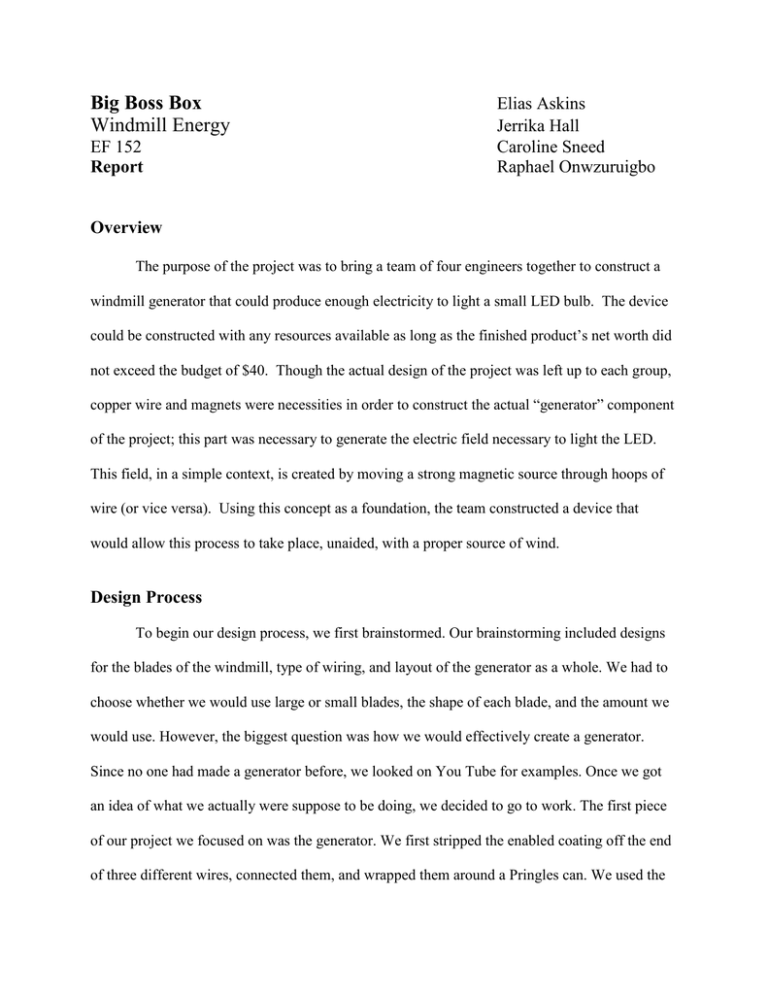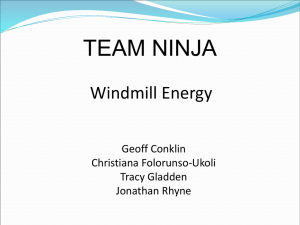Big Boss Box Windmill Energy Elias Askins
advertisement

Big Boss Box Windmill Energy EF 152 Report Elias Askins Jerrika Hall Caroline Sneed Raphael Onwzuruigbo Overview The purpose of the project was to bring a team of four engineers together to construct a windmill generator that could produce enough electricity to light a small LED bulb. The device could be constructed with any resources available as long as the finished product’s net worth did not exceed the budget of $40. Though the actual design of the project was left up to each group, copper wire and magnets were necessities in order to construct the actual “generator” component of the project; this part was necessary to generate the electric field necessary to light the LED. This field, in a simple context, is created by moving a strong magnetic source through hoops of wire (or vice versa). Using this concept as a foundation, the team constructed a device that would allow this process to take place, unaided, with a proper source of wind. Design Process To begin our design process, we first brainstormed. Our brainstorming included designs for the blades of the windmill, type of wiring, and layout of the generator as a whole. We had to choose whether we would use large or small blades, the shape of each blade, and the amount we would use. However, the biggest question was how we would effectively create a generator. Since no one had made a generator before, we looked on You Tube for examples. Once we got an idea of what we actually were suppose to be doing, we decided to go to work. The first piece of our project we focused on was the generator. We first stripped the enabled coating off the end of three different wires, connected them, and wrapped them around a Pringles can. We used the volt meter to check the resistance and voltage of our first generator. The resistance was too high and we hardly received any voltage, so we decided to start over. Next, instead of scrapping the wires with scissors and sand paper, we melted the wires together by soldering to ensure all the coating was off. This did not work, and gave us similar results to our first generator. We came to a conclusion that the result of the high resistance and low voltage was due to the connection of the various wires, so we decided to use one long wire. Also in the process we decided to wrap the wire vertically and horizontally around the Pringles can to receive a higher voltage. We positioned four magnets horizontally inside of the Pringles can to optimize the voltage. To capture the most air, we decided to use small wooden rounded blades that we positioned at angle for our windmill. Through trail and error, we created the best possible way of making our generator. Description of Device Our final device’s structure is a plexi-glass box raised by a few scrap pieces of wood to allow extra room for our fan’s radius. We guled our generator on the inside of it with hot glue. Our generator consists of a Pringles can, wrapped both lengthwise and circumference-wise in one continuous enamel covered wire. We wrapped it both ways in order to maximize the capture of electrons. The windmill part of our project came from an old Christmas decoration used to capture heat from candles. We transformed this old decoration by disassembling it, then gluing the propellers into place, and attaching the entire piece to the metal rod. The magnets are glued to the other end of this metal rod (which goes through the ball bearing). So, when the fan spins, so do the magnets. The magnets extend into the Pringles can, completing the generator. Estimated Efficiency Bill of Materials Pringles can Plexi-glass box Windmill Wood Wire Magnets Metal Rod and Ball Bearing Scrap Wood Hot Glue Total $0.75 $15.00 $5.00 $10.00 $3.00 $5.00 $1.00 $0.25 $40.00 Conclusions In the end, our group was successful in the creation of our windmill and the generation of electricity. Individually, we each took away different learning experiences. For instance, some of us learned what a generator even was and how they work. We learned how to position the magnets and the wire to optimize the generator performance. We had the chance to use new tools such as the soldering iron. As a team, we all learned about various types of wires, and what to do in order to minimize resistance in an electrical circuit. We also were able to practice working together through frustration while we sorted through all of our wire complications. References “Ultra-Simple Electric Generator” William Beaty amasci.com/coilgen.html Dr. Arazi’s lecture notes Professor Schleter & Dr. Bennett YouTube.com
